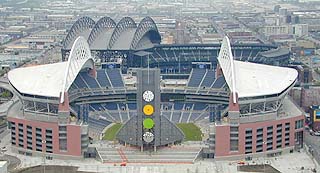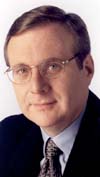
DJC.COM
June 27, 2002
Is no news good news?
Special to the Journal

Courtesy of Public Stadium Authority Once they move into their new stadium, the Seahawks hope to duplicate the competitive and financial success of the Mariners at Safeco Field, which stands in the background.
|
The new Seattle Seahawks stadium is stirring little controversy compared with the debate-laden construction of Safeco Field.
It’s also generating less excitement.
For all its heated talks over costs, taxes and location, Safeco captured Seattle’s imagination.
By contrast, business and community leaders admit, the Seahawks venue is moving along swimmingly. Its pieces are in place: The team’s owner and key financier pledges to cover stadium cost-overruns. Crews are meeting construction goals on time and on budget.
The lack of bad news about the Kingdome’s replacement has meant little news at all. But the hope is that buzz will abound once thousands of Seattleites sit in the stadium for their first Seahawks games — especially if the team starts winning early.
|
“It’ll be exciting, and it’ll be new,” says Bob Wallace, CEO of Wallace Properties, a Bellevue-based commercial real estate firm. “But as the Mariners have demonstrated, you have to field a competitive team to sustain that kind of enthusiasm.”
The $430 million football stadium and exhibition center will be financed largely through lottery ticket sales, King County car rental and hotel taxes, and $130 million in private-sector contributions led by Paul Allen. Also, unlike Mariners ownership, Allen agreed to cover unforeseen costs.
Safeco’s construction five years ago came after voters defeated a county sales tax hike. The state legislature then, in a special session, authorized a funding package including county food and beverage tax increases, car rental surcharges and ballpark admissions taxes.
“For all intents and purposes, the issue of financing was basically beat to death,” says local community activist Art Skolnik, founder of the Association of King County Historical Organizations and a fellow of the American Institute of Architects.

Allen |

Steinbrueck |
Other key differences between Safeco and the new Seahawks venue: In addition to approving Safeco’s funding package, the King County Council established the Washington State Major League Baseball Public Facilities District to own the ballpark and manage its construction south of the Kingdome. All meetings thereafter were open to public review — and backlash.
The Seahawks stadium comes after voters in 1997 approved a statewide referendum to replace the Kingdome with a new football/soccer stadium and exhibition center.
“Paul Allen ran an efficient campaign preceding the citizens’ vote for the Seahawks,” says Seattle City Council President Peter Steinbrueck.
“His goodwill has helped to soften the introduction of the new stadium and the lack of sentimentality about the old one. There’s been relatively little to be concerned about.”
Added Wallace: “There hasn’t been much question that Allen is capable of doing what he wants to do.”
Commercial real estate developer Greg Smith says he believes the new Seahawks stadium is stirring little controversy largely because it replaces the aging Kingdome with a better venue.
“The idea of a new baseball stadium was first. Once that decision was made, football couldn’t be nearly as controversial,” adds Smith, a partner with Martin Smith Inc. and president of the related Martin Smith Development Corp.
“People just have to get excited about it and experience it. Once you step in it, it’s incredible,” Smith said.
End-zone seats in the 72,000-capacity stadium sit 40 feet from the field, and sideline seats 52 feet. It has wider concourses and more restrooms than the Kingdome, and while it’s an open-air venue, 70 percent of Seahawks fans will sit under the roof.
“The football stadium has to follow in the wake of Safeco Field, but it’s turned into a nice architectural statement,” Skolnik says.
“It gives a higher percentage of people in the stadium great seats. No one sits that far away. It’ll deliver a better view for the spectator.”
Steinbrueck, also an architect, says he snagged a chunk of Kingdome concrete as a souvenir after the stadium was torn down last year. “The general public has yet to discover how wonderful the new facility really is. It’s a really well-designed, comfortable new facility,” he says.
The Mariners moved into Safeco on the cusp of becoming one of the most successful baseball teams in American League history. To generate some real buzz as they launch their season in a new stadium, all the Seahawks must do is follow suit.
A tall order, but Steinbrueck is optimistic.
“I think Seattle has been more of a baseball town in recent years, but I think the Seahawks will build up much in the way the Mariners have,” he says.
Stadium ownership and management firm First & Goal Inc. invites fans to visit the stadium before the Seahawks’ first preseason home game against the Indianapolis Colts Aug. 10.
Ari Kramer is a Seattle-based freelance writer.
Other Stories:
- Designing Seattle’s newest landmark
- The six million dollar mitigation
- Soft soil makes for tough design
- Taking fans beyond the game
- Driven piles make stadium strong
Copyright ©2009 Seattle Daily Journal and DJC.COM.
Comments? Questions? Contact us.